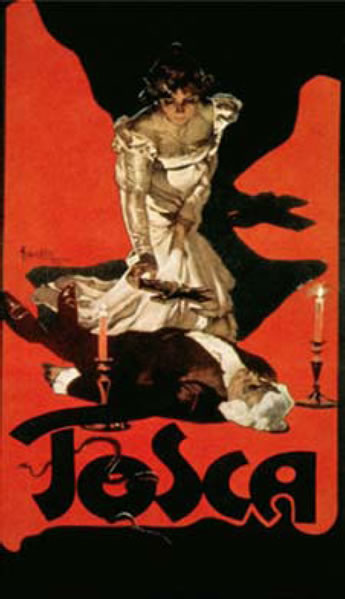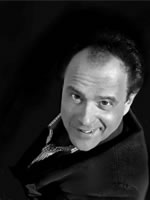
Tosca
by Giacomo Puccini
Tosca is an opera in three acts by Giacomo Puccini to an Italian libretto by Luigi Illica and Giuseppe Giacosa, based on Victorien Sardou's drama, La Tosca. The work premiered at the Teatro Costanzi in Rome on January 14, 1900. It is one of the world's most popular operas, a hit with audiences from its first performance.
Tosca Cast Members
Fabiana Bravo (Tosca)
Fabiana Bravo made her professional debut in 1996 as Lucia in Lucia de Lamermoor with Luciano Pavarotti at the Academy of Music in Philadelphia after winning the 5th Luciano Pavarotti International Voice Competition. Since then she has achieved recognition as Tosca, Madama Butterfly, Norma, Ariade auf Naxos, La Gioconda, Mimi in La Bohème, Countess Almaviva in Le Nozze di Figaro Donna Anna in Don Giovanni, Nedda in I Pagliacci, Leonora in Il Trovatore, Madame Ledoine Les Dialogues des Carmelites, Desdemona in Otello, Amelia in Un Ballo in Maschera, and Leonora in Verdi’s Oberto. amongst others.

Jonathan Burton (Cavaradossi)
Mauro Augustini (Scarpia)
Winner of the "TOTI DAL MONTE" vocal competition at Treviso, winner of the prizes "GALEFFI" and "BASTIANINI" at Busseto, and recipient of a scholarship for studies at Parma, with studies at the Conservatory at Milan, under the guidance of Pier-Miranda Ferraro. His debut came with Scarpia in Tosca at Saragoza (Spain). Soon thereafter came perfomancess of TOSCA at Pistoia, TROVATORE at the Malatestian Court at Fano, and Rovigo, PAGLIACCI at the Teatro Comunale at Treviso, Padova and Rovigo. His vocal Technique studies were under Mario del Monaco, wit interpretrive studies with Tito Gobbi, musical preparation under the guidance of Enza Ferrari.

Michael Gallup (Sacristan)

Phillip Skinner (Angelotti/Sciarrone)

Daniel Kurek (Spoletta)

Jeffrey Stevens (Jalier)
Anthony Laciura (Director)
Time flies when you’re enjoying yourself. That popular sentiment occurred to Anthony Laciura as he heard an announcer introduce him as the host for a recent Saturday afternoon Metropolitan Opera broadcast.
The Story of Tosca
Act I
Rome, June 1800, The Church of Sant’Andrea della Valle, Napoleon Bonaparte is advancing with his army. Bonaparte is the political enemy of Scarpia and the hero of Cavaradossi and Angelotti. Angelotti, an escaped political prisoner, takes refuge in a side chapel of the church of Sant’Andrea della Valle in Rome. An elderly sacristan comes to tidy up, followed by Cavaradossi, a painter, who is at work on a portrait of the Madonna. Cavaradossi compares his Madonna’s blonde-haired, blue-eyed charm with the dark beauty of his lover, the famous singer Floria Tosca (“Recondita armonia”).
Angelotti emerges from hiding to find Cavaradossi, his political ally, who promises to help his friend escape from Rome. Angelotti hides again at the sound of Tosca’s voice from outside. Tosca jealously demands to know why the door was locked. Cavaradossi reassures her, and they join in a passionate duet (“Non la sospiri”). Once Tosca has gone, Angelotti reappears and he and Cavaradossi plan his flight. A cannon shot from the Castel Sant’Angelo announces the discovery of Angelotti’s escape. They exit. The sacristan enters followed by clerics and choir boys, all excited by rumors of Bonaparte’s defeat (“Tutta qui la cantoria”). Baron Scarpia, the chief of police, arrives with his henchman Spoletta in search of the escaped prisoner. Tosca returns, and Scarpia plays upon Tosca’s jealousy in hopes of discovering Angelotti’s whereabouts (“Tosca divina”). When she leaves to seek her lover, Scarpia has her followed. As the crowd intones the “Te Deum,” Scarpia vows to bring Cavaradossi to the gallows and Tosca into his arms (“Va, Tosca! Nel tuo cuor s’annida Scarpia”).
Act II
Scarpia’s study in the Palazzo Farnese; that evening. Alone at dinner, Scarpia reviews his plot. Spoletta reports that he and his men trailed Tosca to the villa and found no trace of Angelotti, but placed Cavaradossi under arrest. Cavaradossi is brought in and questioned. Scarpia has sent for Tosca, and she enters as Cavaradossi is taken away to be tortured. Upon hearing his anguished cries, Tosca reveals Angelotti’s hiding place. Cavaradossi is dragged into the study. His anger at Tosca’s betrayal turns to joy when Sciarrone announces that Bonaparte has actually defeated Melas at Marengo. The enraged Scarpia sends Cavaradossi back to his cell.
Tosca asks the price of her lover’s freedom. Scarpia will accept only Tosca’s submission. “Vissi d’arte” (“I have lived for art”), Tosca sobs to herself in a celebrated aria: she has devoted her life to music and piety, why does God repay her with misery? As she struggles to free herself from Scarpia’s embrace, Spoletta enters with the news that Angelotti has killed himself rather than be arrested. Ashamed, Tosca signals that she will give in to the Baron, on condition that Cavaradossi be set free at once. Scarpia explains that he cannot grant a pardon; he can only release Cavaradossi by faking his death in a mock execution. Tosca demands that Scarpia provide a note of safe conduct for herself and Cavaradossi. While he is writing, Tosca catches sight of a sharp knife on his dinner table and, unnoticed, takes it. Scarpia seals the note, then turns eagerly to embrace the trembling diva. “Questo è il bacio di Tosca!” (“This is Tosca’s kiss!”), she cries, plunging the knife deep into his heart. Scarpia cries out for help as Tosca curses him. She takes the safe-conduct pass and slips out of the room.
Act III
The Castel Sant’Angelo; dawn of the following day. Soldiers bring Cavaradossi to the ramparts of the fortress. He reflects on his love for Tosca (“E lucevan le stelle”). Tosca rushes in with the note of safe conduct and the story of Scarpia’s violent death. Cavaradossi praises her courage, saying that her gentle hands were not meant for murder (“O dolci mani”). Tosca instructs him in the plan of the feigned execution: after the gunshots he is to lie still until she gives him a signal. Though she believes the execution to be a farce, Tosca is filled with anxiety as her lover is led before the soldiers. They fire and Cavaradossi falls to the ground. Tosca whispers to him to remain motionless until everyone has gone. At last she tells him it is safe, but he does not respond. With a piercing scream, Tosca realizes Scarpia’s final deceit. She weeps over Cavaradossi’s body as Spoletta and Sciarrone, having found the Baron murdered, burst in to arrest her. Too quick for them, she runs to a parapet, shouts “O Scarpia, avanti a Dio!” (“Oh Scarpia, we shall meet before God!”), and hurls herself to her death.
© Copyright OPERA NEWS 2007. Reprinted with permission



.jpg)
.jpg)
.jpg)


